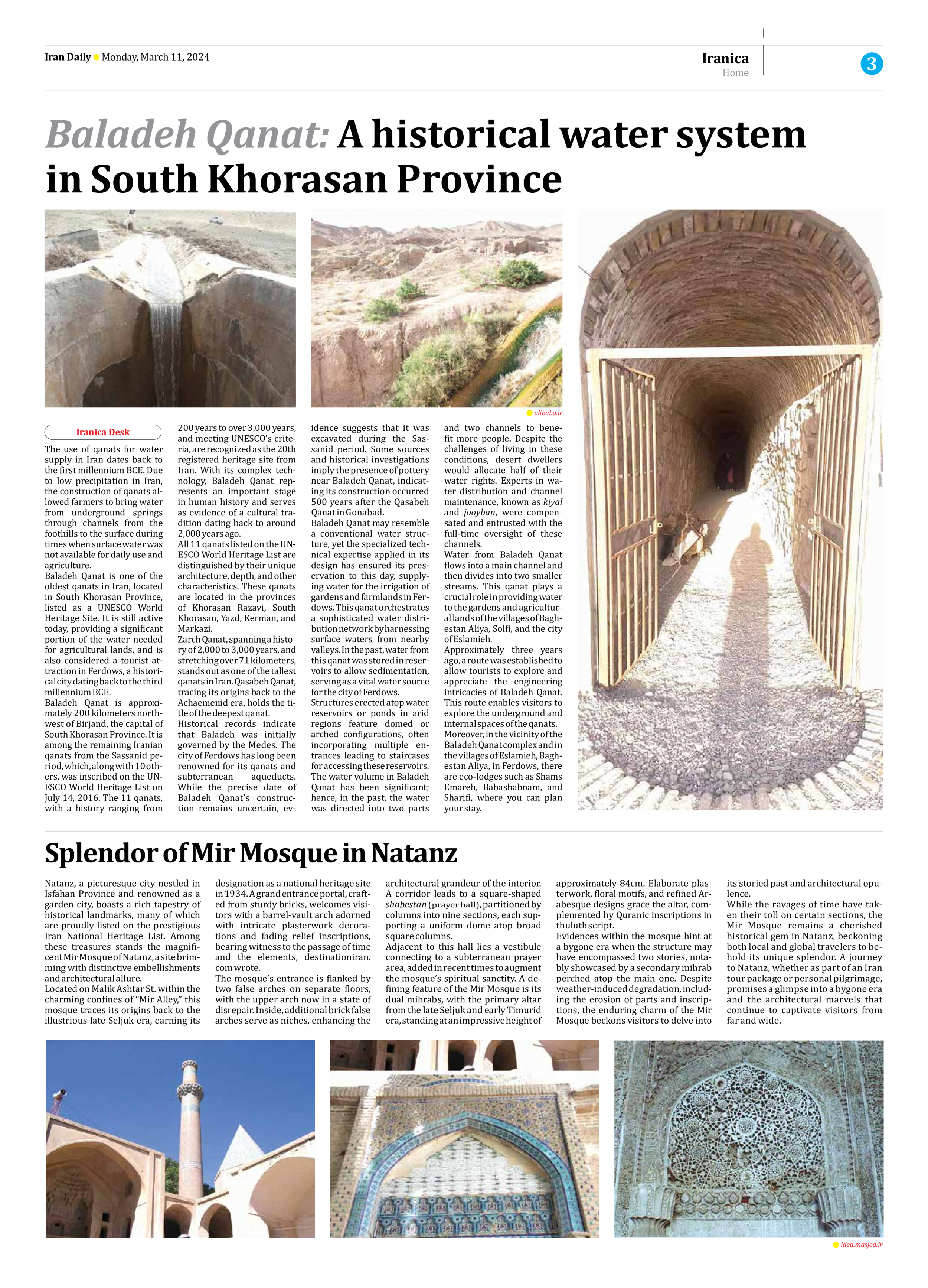
Baladeh Qanat: A historical water system in South Khorasan Province
The use of qanats for water supply in Iran dates back to the first millennium BCE. Due to low precipitation in Iran, the construction of qanats allowed farmers to bring water from underground springs through channels from the foothills to the surface during times when surface water was not available for daily use and agriculture.
Baladeh Qanat is one of the oldest qanats in Iran, located in South Khorasan Province, listed as a UNESCO World Heritage Site. It is still active today, providing a significant portion of the water needed for agricultural lands, and is also considered a tourist attraction in Ferdows, a historical city dating back to the third millennium BCE.
Baladeh Qanat is approximately 200 kilometers northwest of Birjand, the capital of South Khorasan Province. It is among the remaining Iranian qanats from the Sassanid period, which, along with 10 others, was inscribed on the UNESCO World Heritage List on July 14, 2016. The 11 qanats, with a history ranging from 200 years to over 3,000 years, and meeting UNESCO’s criteria, are recognized as the 20th registered heritage site from Iran. With its complex technology, Baladeh Qanat represents an important stage in human history and serves as evidence of a cultural tradition dating back to around 2,000 years ago.
All 11 qanats listed on the UNESCO World Heritage List are distinguished by their unique architecture, depth, and other characteristics. These qanats are located in the provinces of Khorasan Razavi, South Khorasan, Yazd, Kerman, and Markazi.
Zarch Qanat, spanning a history of 2,000 to 3,000 years, and stretching over 71 kilometers, stands out as one of the tallest qanats in Iran. Qasabeh Qanat, tracing its origins back to the Achaemenid era, holds the title of the deepest qanat.
Historical records indicate that Baladeh was initially governed by the Medes. The city of Ferdows has long been renowned for its qanats and subterranean aqueducts. While the precise date of Baladeh Qanat’s construction remains uncertain, evidence suggests that it was excavated during the Sassanid period. Some sources and historical investigations imply the presence of pottery near Baladeh Qanat, indicating its construction occurred 500 years after the Qasabeh Qanat in Gonabad.
Baladeh Qanat may resemble a conventional water structure, yet the specialized technical expertise applied in its design has ensured its preservation to this day, supplying water for the irrigation of gardens and farmlands in Ferdows. This qanat orchestrates a sophisticated water distribution network by harnessing surface waters from nearby valleys. In the past, water from this qanat was stored in reservoirs to allow sedimentation, serving as a vital water source for the city of Ferdows.
Structures erected atop water reservoirs or ponds in arid regions feature domed or arched configurations, often incorporating multiple entrances leading to staircases for accessing these reservoirs.
The water volume in Baladeh Qanat has been significant; hence, in the past, the water was directed into two parts and two channels to benefit more people. Despite the challenges of living in these conditions, desert dwellers would allocate half of their water rights. Experts in water distribution and channel maintenance, known as kiyal and jooyban, were compensated and entrusted with the full-time oversight of these channels.
Water from Baladeh Qanat flows into a main channel and then divides into two smaller streams. This qanat plays a crucial role in providing water to the gardens and agricultural lands of the villages of Baghestan Aliya, Solfi, and the city of Eslamieh.
Approximately three years ago, a route was established to allow tourists to explore and appreciate the engineering intricacies of Baladeh Qanat. This route enables visitors to explore the underground and internal spaces of the qanats.
Moreover, in the vicinity of the Baladeh Qanat complex and in the villages of Eslamieh, Baghestan Aliya, in Ferdows, there are eco-lodges such as Shams Emareh, Babashabnam, and Sharifi, where you can plan your stay.







